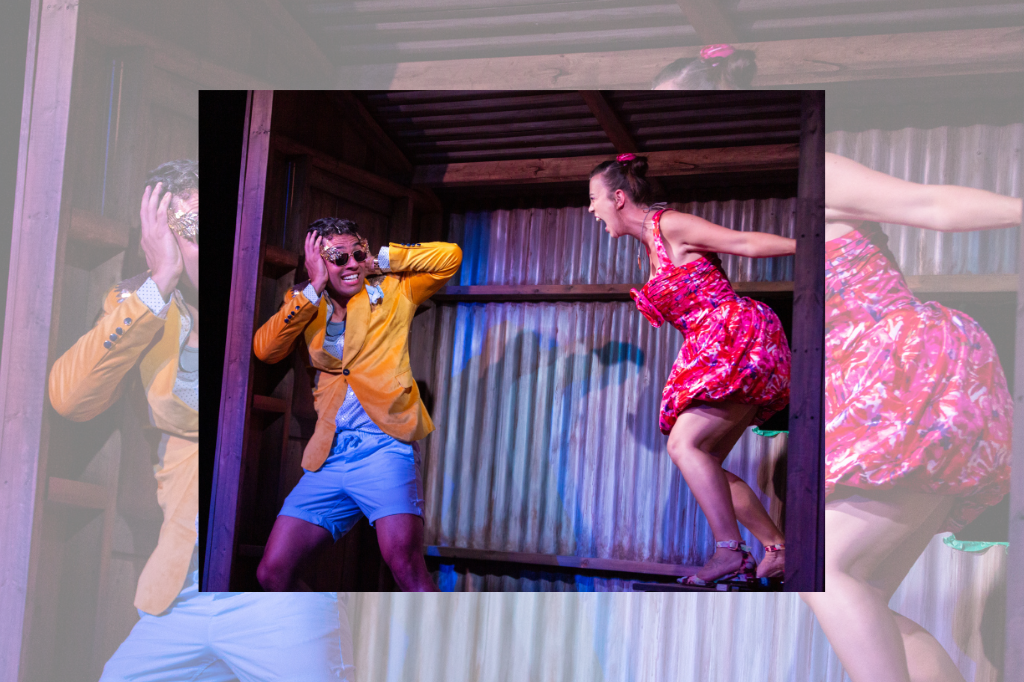REVIEW: Trojan Girls & The Outhouse of Atreus at Factory Theatre/Outside the March in Association with Neworld Theatre
Let us now away to ancient Greece — or, er, Grease. Or both, as is the case in Trojan Girls & The Outhouse of Atreus, the multi-worlded, tongue-in-cheek marvel in residence at Factory Theatre (at least physically speaking — it’s co-produced by Outside the March and Neworld Theatre).
Partly immersive and wholly ambitious, Trojan Girls & The Outhouse of Atreus is an adaptation of Gillian Clark’s The Ruins, and Mitchell Cushman’s directorial conceit is built on what should be a foundation of impossibility: two plays are performed simultaneously by one cast. Eight actors play sixteen parts, gallivanting between Factory’s courtyard and its studio space. Outside, the actors play teenagers — greasers and grifters bound to the monotony of the fictional New Troy, Ontario. Their parents are tyrannical, their fates rigid and frightening. Inside lies a lower-stakes affair, in which the youths’ parents facilitate New Troy’s annual Duck n’ Swing dance and search for existential meaning inside an outhouse.
There’s a distinct coming-of-age thread woven throughout the stories, connecting the failures of the parents with the insecurities of the children. Eighteen-year-old Penelope straddles both worlds, the object of affection for both her peers and her elders. Cassandra, the young soothsayer shrouded in quirks, knows something awful will happen tonight — but no one will believe her. Ned is a veteran with a tortured soul and a thin thread of belief in tradition and community. Hecuba and Cassandra lost their mother in a drowning accident, and her spirit lives on only when the sisters come together.
Through small stories of personal grief and collective memory playwright Clark creates a melancholy snapshot of small-town youth, smartly studded with Grease references and oodles of yearning, sexual energy. The overarching story seems to be Cassandra’s prophecy — interlocked with a high-stakes prom-posal for Penelope — though the magic here happens in the details, and less so in the big-picture plot(s) of Trojan Girls & The Outhouse of Atreus.
It’s a Cushman/Outside the March affair through and through, meticulous and sprawling, jam-packed with ideas on what theatre is, what theatre does, and how theatre does it with the help of its audience. Bound together by a world-class cast of young actors, the production often soars to impossible emotional heights: there is not a single weak link onstage, all the more impressive considering the physical demands of each track. Elena Reyes as Andromache/Elektra, Amy Keating as Cassandra/Ned/Artemis, and Katherine Cullen as Helen/Nestra are standouts, but they’re also afforded the most compelling material — Cheyenne Scott’s Penelope, Merlin Simard’s Thalthybius/Hermes, Jeff Yung’s Odysseus/Orestes, Liz Der’s Hecuba/Penthesilea/Artemis, and Sébastien Heins’ Menelaus/King Memnon are provocative and strong, too.
But a knockout cast doesn’t absolve the Trojan girls or their outhouse of the fact that Cushman’s two-plays-one-cast vision doesn’t quite work here — it’s simply too much, and bisecting the plays reveals cracks in each one. The connective tissue between the grimy New Troy and the folksy Duck n’ Swing atrophied for me at intermission, and by the time the audience had the chance to absorb both halves of the experience, the relatedness of the two halves felt a little forced. The outside portion is simply inspired, with sneaky entrances against the chaos of Bathurst Street. Even with a fence between the Factory Courtyard and the rest of the world, the noises and topography of 2022 Toronto pervade the story, and they’ve been used playfully in the realization of the teenagers’ stories. The outside portion is so good that, for me, it was sorely missed during the more traditional play staged indoors. But an outdoor campfire also presents some real challenges to audience members. It’s definitely real smoke, and those sitting in front of the fire pit may struggle to breathe — folks certainly did at the performance I attended.
The creative team has made magic of the Grease references in Clark’s often-funny script, cladding cast members in funky costumes (Nick Blais) and bolstering New Troy with suspenseful, effective music and sound (Heidi Chan). Michael Laird’s audio system design worked perfectly the night I attended — no small feat against the ruckus of the Bathurst/Adelaide intersection — and the total care and competence of stage managers Daniel Oulton and Meghan Speakman is keenly felt throughout both halves of Trojan Girls & The Outhouse of Atreus.
I may go see the production a second time. I get the sense it’s a wildly different experience, depending on which play you elect to see first — I found it interesting that critics weren’t given a choice on opening night, while other audience members were. Trojan Girls & The Outhouse of Atreus is a total feat of storytelling and logistical planning, and the idea of a two-play-one-cast project might work in dialogue with a less complicated script. But at three hours plus intermission, the story here feels so vast that even a perfect cast can’t quite bring it back down to earth.
Trojan Girls & The Outhouse of Atreus runs at Factory Theatre through August 28. Tickets are available here.















Comments